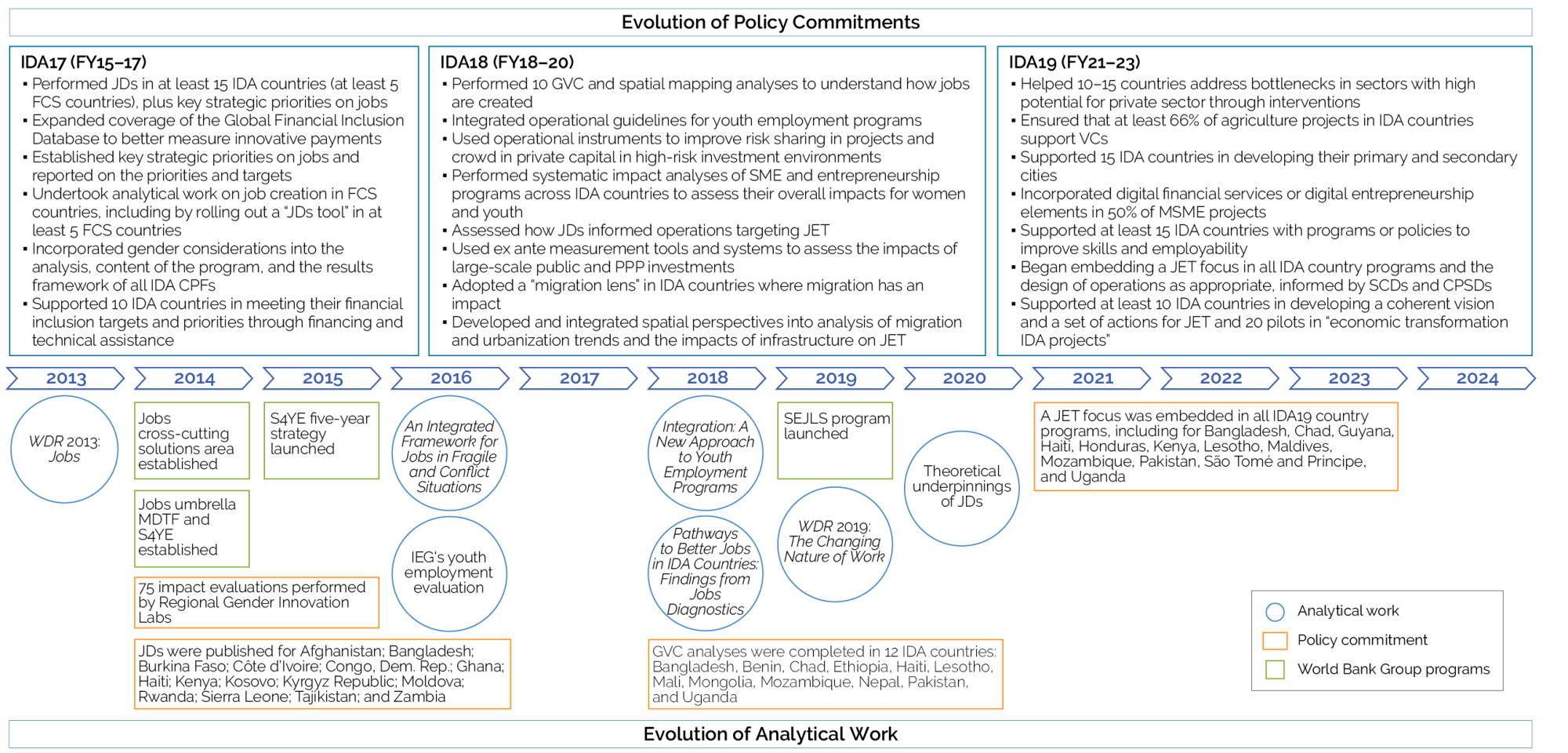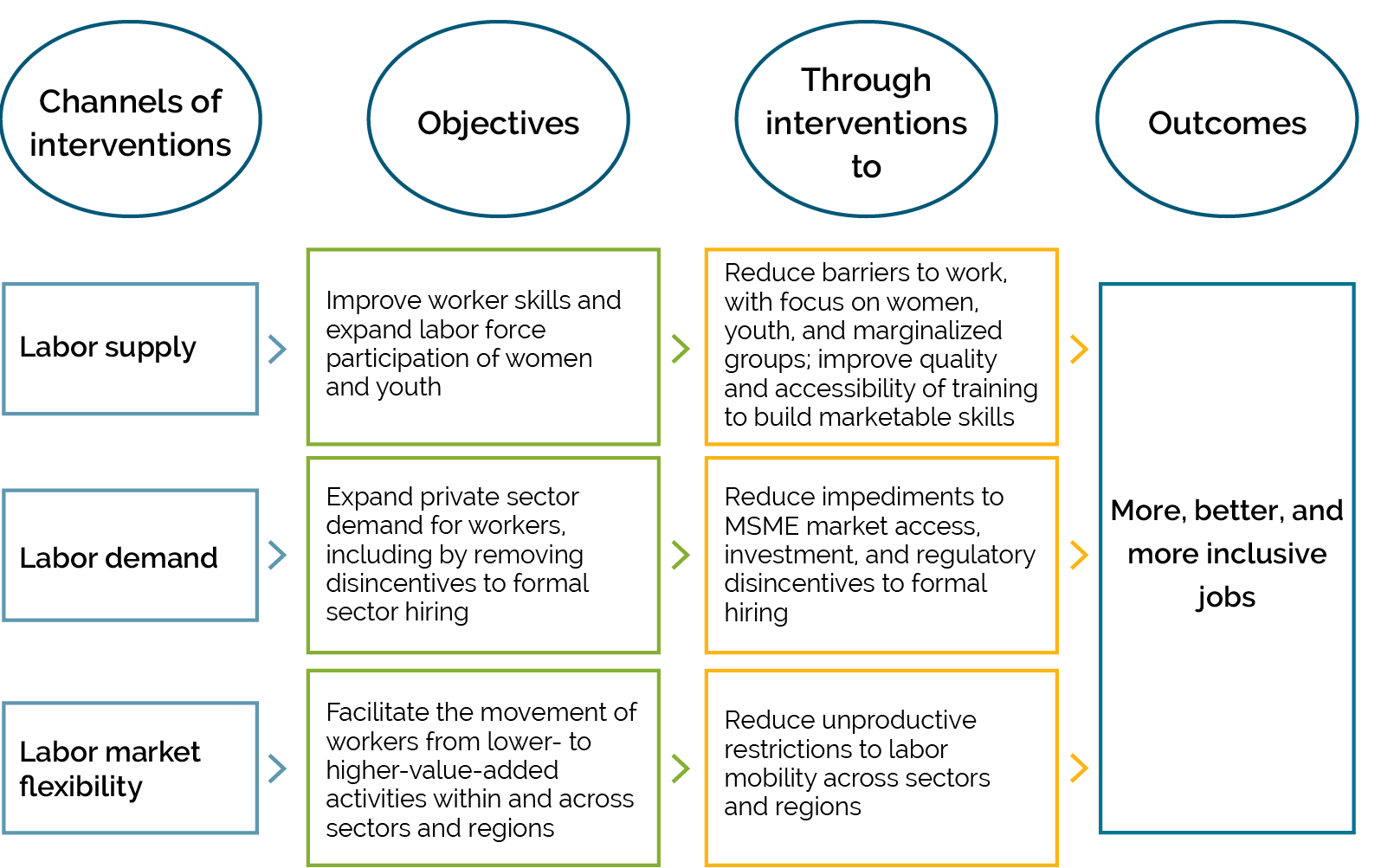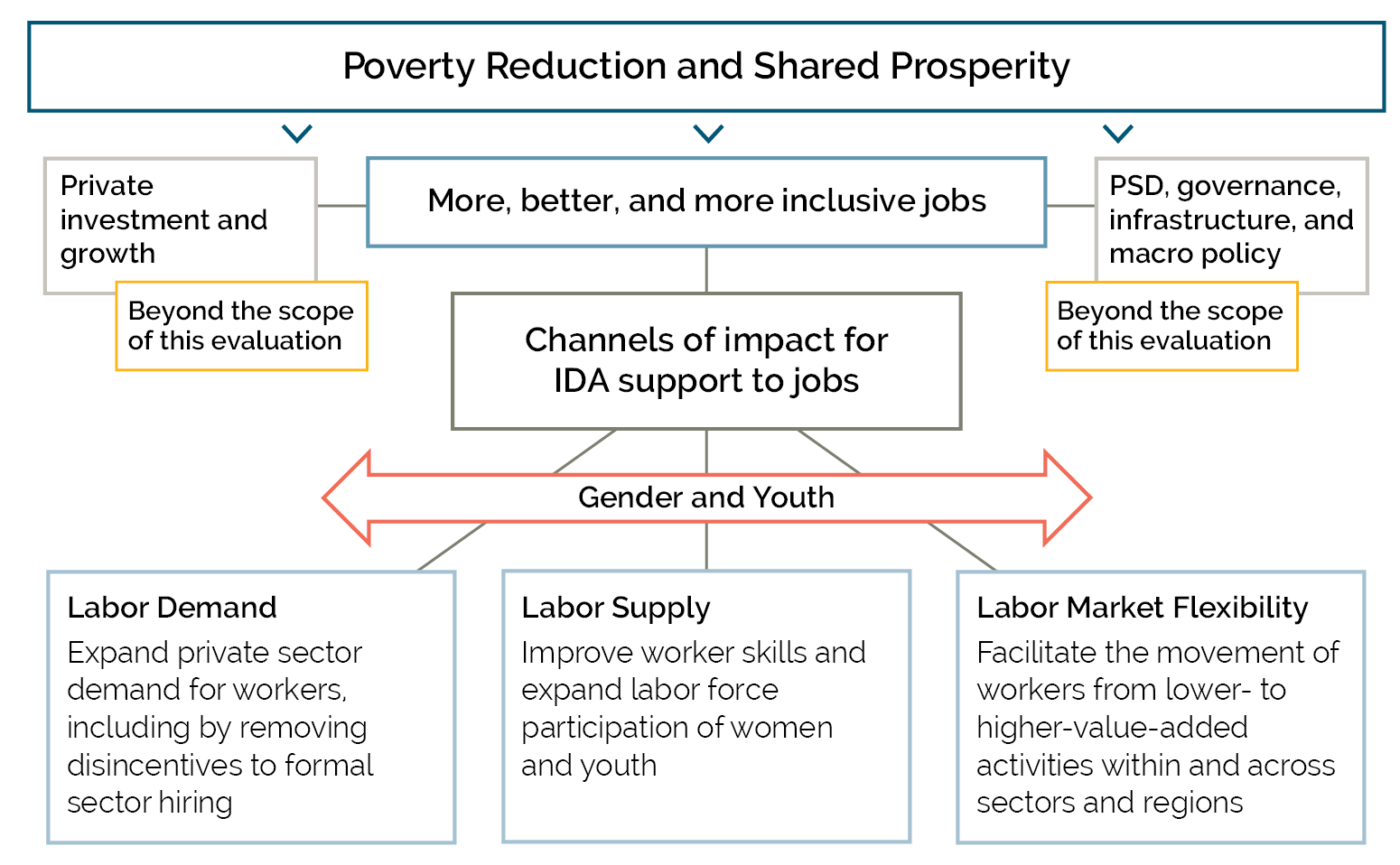World Bank Support to Jobs and Labor Market Reform through International Development Association Financing
Chapter 1 | Introduction
Highlights
In countries eligible for International Development Association (IDA) financing, the challenges related to jobs are multifaceted and have compounded effects on poverty and inequality.
Since 2014, IDA has included a special theme on jobs, and, over the subsequent three Replenishments, it enhanced its policy commitments to realize its stated jobs objectives.
This evaluation focuses on IDA-supported interventions that directly address constraints to the key objectives of more, better, and more inclusive jobs across three IDA cycles in a portfolio of 257 IDA-financed World Bank projects approved during fiscal years 2015–22.
This evaluation assesses the analytical underpinnings and operational relevance of the IDA jobs strategy and the design and performance of jobs interventions.
In countries eligible for International Development Association (IDA) financing, jobs challenges are multifaceted and have compounded effects on poverty and inequality. These countries face six major types of challenges. First, both income and consumption inequality are driven by inequality in labor earnings (Fields 2011a) and inequality of opportunities based on gender, ethnicity, or age. Second, underemployment, not unemployment, is the main challenge for many low-income countries (Merotto, Weber, and Aterido 2018), where poor people have work but are unable to earn sufficient income to lift themselves out of poverty. This is particularly true of women and youth, whose labor force participation is much higher than in International Bank for Reconstruction and Development countries but who tend to work in informal and low-paid jobs (figure 1.1, panel a). Third, informality can be a significant challenge to better jobs for many people in emerging markets and developing economies, where low-productivity and low-value-added informal jobs have been estimated to account for 70 percent of employment and about one-third of the GDP (Ohnsorge and Yu 2022). Informal workers are more likely to lose their jobs or suffer severe income losses during crises, such as the COVID-19 pandemic, and they tend to be largely excluded from social safety nets. Informal jobs have also been associated with broader development challenges (World Bank 2019b, 2020b). Fourth, high unemployment and unmet job expectations among youth, as well as significant gender gaps for both workforce participation rates and labor income, are immediate concerns (ILO 2017; World Bank 2014a). Fifth, almost 80 percent of labor productivity growth in low-income countries came from the reallocation of labor from lower-productivity agriculture into relatively higher-productivity services and industry (Merotto, Weber, and Aterido 2018). However, low-income economies are usually unable to absorb all the workers released from agriculture into higher-productivity and higher-paying wage employment. This suggests that labor market flexibility and worker employability are important intervention channels to support jobs-related objectives. Sixth, there can be trade-offs among various interventions supporting jobs objectives; for example, although raising agricultural productivity can increase earnings, it often leads to decreased employment in the sector.
Figure 1.1. Trends in Labor Force and Employment Ratios for IDA Countries Compared with IBRD Countries
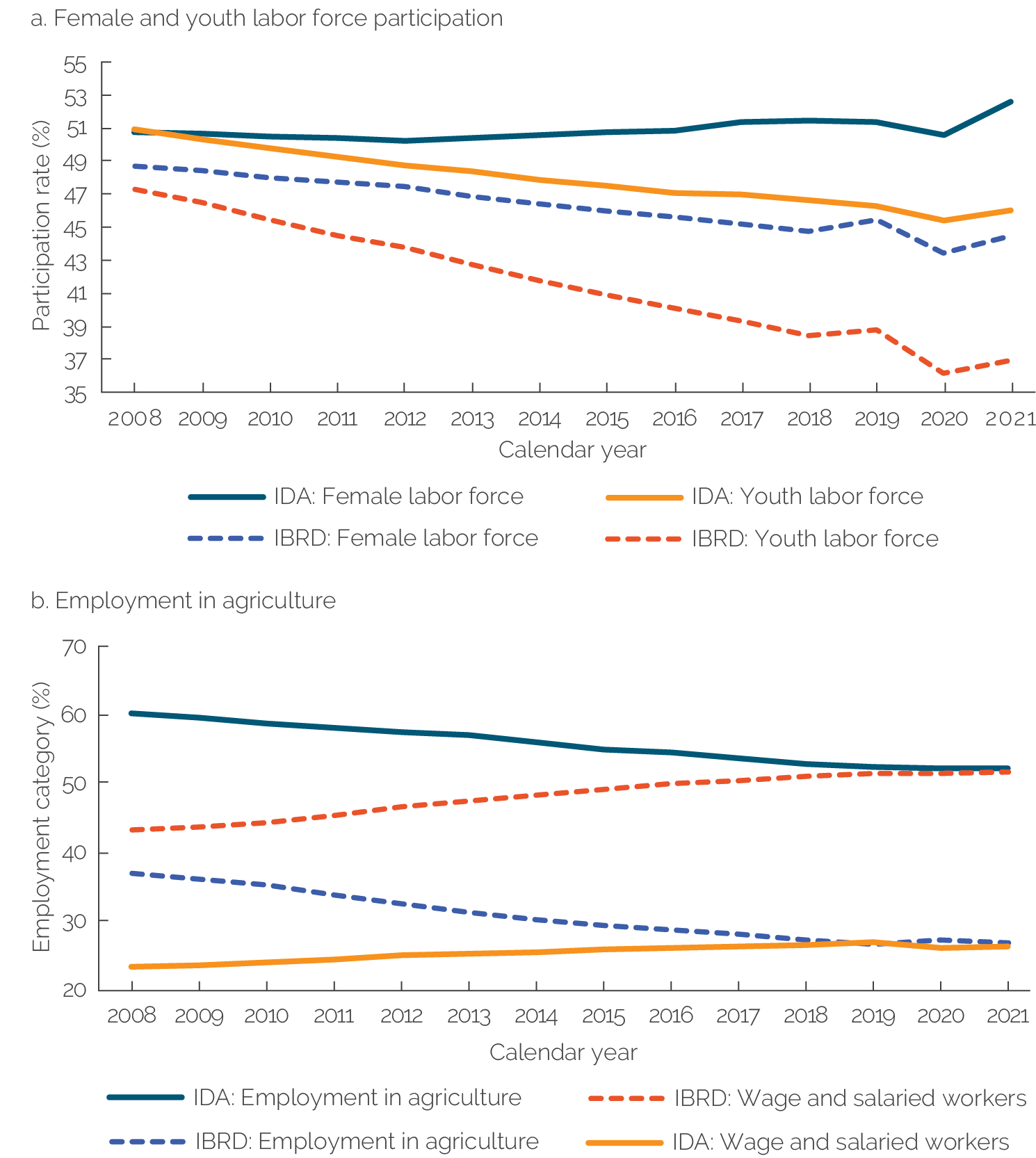
Source: International Labour Organization 2021.
Note: Data presented are modeled estimates by the International Labour Organization. Female labor force participation rate is the ratio of female labor force to female population 15 years of age and older, and that for youth is the ratio of youth 15–24 years of age in the labor force to total population 15–24 years of age. Employment in agriculture and wage and salaried workers is the relative ratio of employment in these categories to total employment. IDA and IBRD aggregates are for IDA-only and IBRD-only countries and are based on weighted averages as published in World Bank’s World Development Indicators database. IBRD = International Bank for Reconstruction and Development; IDA = International Development Association.
More, better, and more inclusive jobs are critical for poverty reduction and shared prosperity in IDA-eligible countries. “Inclusive jobs” refers to both more jobs and improved access to jobs and opportunities for populations. The World Development Report 2013: Jobs (World Bank 2012a) highlighted the importance of pursuing multiple jobs-related objectives, including higher jobs growth and improved development dividend from jobs. This dividend can take many forms: for example, jobs help poor people work their way out of poverty and provide higher earnings and economic empowerment specifically to women, who subsequently invest more in their children. Jobs lead to improved efficiency as workers get better at what they do and as more productive jobs appear. Jobs improve social cohesion by bringing people from different backgrounds together and helping to reduce conflict (Filmer et al. 2014; Urdal 2006). The World Development Report on jobs noted that high unemployment and unmet job expectations among youth are immediate concerns and that growth can also be “jobless” (World Bank 2012a, 99). Unemployment rates can be low, particularly where dependence on agriculture is high or the private sector is largely informal and characterized by self-employment, but earnings are also low. As such, promoting full and productive employment and decent work for all is at the core of Sustainable Development Goal 8.
The Evolving Jobs Agenda in International Development Association Countries
IDA has included a special theme on jobs since 2014, and over the subsequent three Replenishments, it enhanced its policy commitments to realize its jobs-related objectives. In the 17th Replenishment of IDA (IDA17), IDA explicitly recognized the role played by labor markets in intermediating between growth and inclusion. Before the IDA17 strategy paper, IDA emphasized growth and the use of social safety nets to mitigate the effects of poverty. This acknowledgment of jobs marked a shift in IDA’s inclusive growth strategy, and jobs became more central to its strategy for inclusive growth and for achieving the twin goals. IDA17, IDA18, and IDA19 established specific policy commitments and results indicators under the jobs-related special theme. The two main policy commitments under IDA17 were the establishment of the jobs diagnostics to be implemented through the newly constituted Jobs Group and the preparation of an integrated jobs strategy for countries classified as fragile and conflict-affected situations. IDA18 established a confluence between jobs and economic transformation and highlighted the role of the private sector in creating “good” jobs in labor-intensive sectors. IDA19 and IDA20 preserved the jobs special theme (figure 1.2).
In this evaluation, the IDA jobs strategy includes three main components: a strategic framework, policy commitments, and the Results Measurement System. The strategic framework sets out jobs-related objectives and potential intervention channels; policy commitments set the stage for country contextualized engagements (both lending and nonlending) by establishing jobs priorities and setting a course toward higher-level outcomes; and the IDA Results Measurement System measures outcomes and effectiveness across three tiers. Tier 1 indicators measure high-level outcomes in IDA-eligible countries, Tier 2 indicators try to capture intermediate outcomes from IDA financing, and Tier 3 indicators aim to gauge institutional effectiveness. Figure 1.2 presents the evolution of the IDA jobs strategy and its analytical underpinning across IDA Replenishments. Appendix F presents the detailed policy commitments and Results Measurement System indicators related to jobs.
Figure 1.2. Evolution of International Development Association Jobs Strategy, FY15–22

Source: Independent Evaluation Group.
Note: CPF = Country Partnership Framework; CPSD = Country Private Sector Diagnostic; FCS = fragile and conflict-affected situation; FY = fiscal year; GVC = global value chain; IDA = International Development Association; IDA17, IDA18, IDA19 = 17th, 18th, and 19th Replenishments of IDA; IEG = Independent Evaluation Group; JD = jobs diagnostic; JET = Jobs and Economic Transformation; MDTF = multidonor trust fund; MSME = micro, small, and medium enterprise; PPP = public-private partnership; S4YE = solutions for youth employment; SCD = Systematic Country Diagnostic; SEJLS = Supporting Effective Jobs Lending at Scale; SME = small and medium enterprise; VC = value chain; WDR = World Development Report.
Evaluation Scope and Framework
This evaluation focuses on IDA-supported interventions that directly address constraints to the key objectives of more, better, and more inclusive jobs over three IDA cycles. For the purposes of this evaluation, jobs are defined broadly as including both wage employment and self-employment in the formal and informal sectors. Relevant jobs-related objectives are more, better, and more inclusive jobs, which lead to improved productivity and incomes and better working conditions. Better jobs are defined as those that are better paid, and more inclusive jobs are defined as those employing women, youth, the bottom 40 percent of the population’s income distribution, and individuals from marginalized groups. For ease of reference in this evaluation, “jobs” is used interchangeably with “the jobs agenda” and “jobs-related objectives.” On the basis of the reviewed literature, the early findings of World Bank jobs diagnostics, IDA jobs strategies, and consultations with experts, we identify three interrelated channels through which IDA support for jobs objectives is pursued: acting on labor demand (including efforts to expand the demand of private sector firms for workers and create the conditions for reliable and adequately remunerated self-employment); increasing labor supply (including efforts to improve the marketable skills of workers, expand the labor force participation of women, and support youth employment); and improving labor market flexibility (including policies to facilitate the movement of workers from lower-productivity to higher-productivity activities within sectors, and from lower-value-added to higher-value-added sectors) and geographic mobility where lack of mobility is identified as a significant constraint in jobs diagnostics. All three channels play a role in achieving IDA’s objectives in the jobs space as per the conceptual framework laid out in figure 1.3.
Figure 1.3. Conceptual Framework
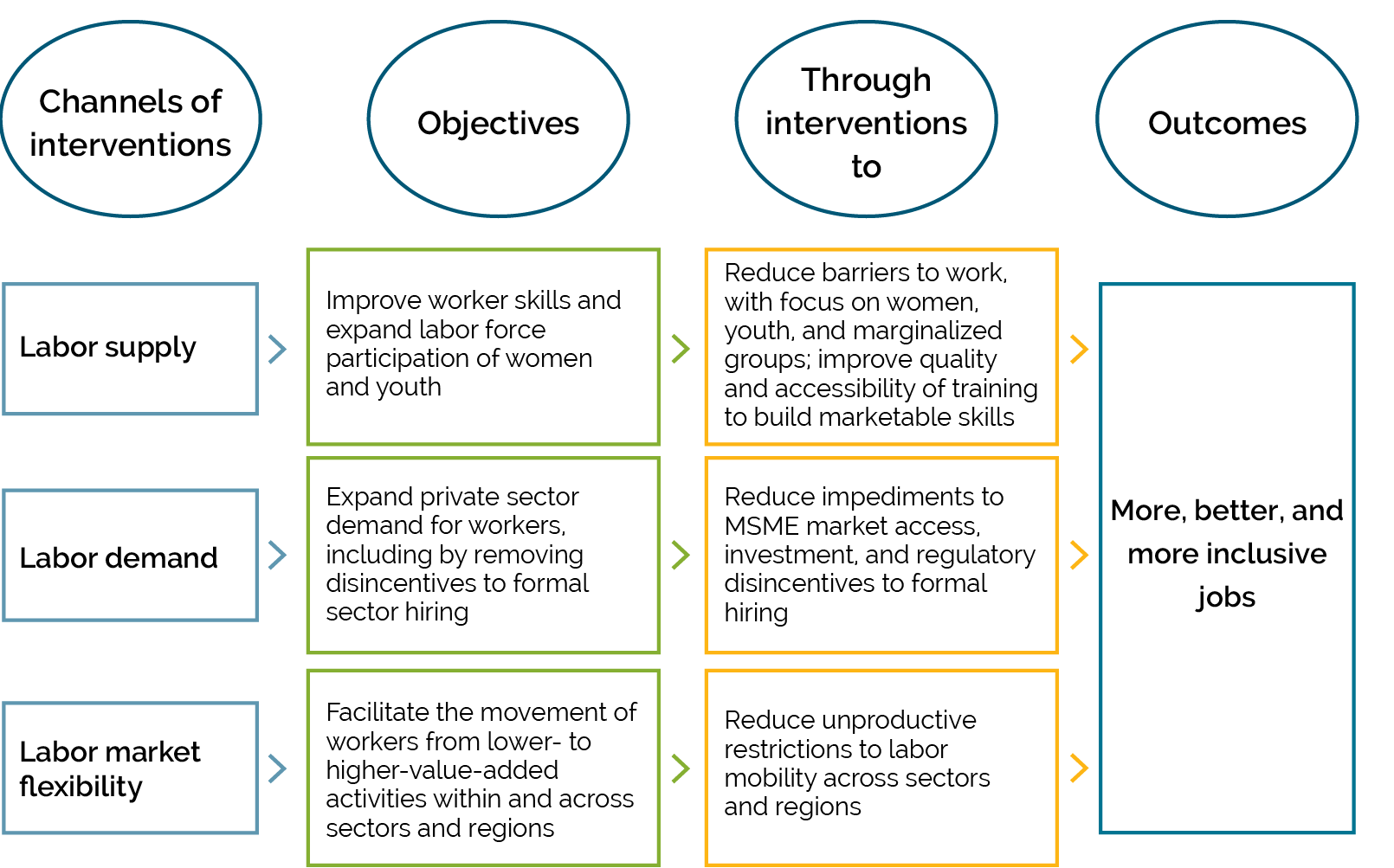
Source: Independent Evaluation Group.
Note: MSME = micro, small, and medium enterprise.
The evaluation focuses on IDA support to policies and operations that directly affect labor demand, labor supply, and labor market flexibility. Although the structural change associated with economic transformation is linked to jobs and growth, the scope of this evaluation is limited to the three main pathways or channels for achieving IDA jobs objectives. Therefore, we do not evaluate the implementation and effectiveness of the economic transformation agenda, given (i) its very broad purview and (ii) the difficulties inherent in measuring the volume and impact of World Bank financing on economic transformation and how it is intermediated through results indicators at the project or Country Partnership Framework (CPF) level. Figure 1.4 presents the scope of this evaluation, with the light gray rectangle outline seen as being relevant to the broader job development agenda but outside the remit of this evaluation. This evaluation focuses on IDA financing implemented by the World Bank. Real sector IDA Private Sector Window transactions of the International Finance Corporation (IFC) are outside the scope of this evaluation. On the basis of a thorough portfolio review, the team also developed a typology of jobs interventions to guide data collection and analysis.
Figure 1.4. Evaluation Scope
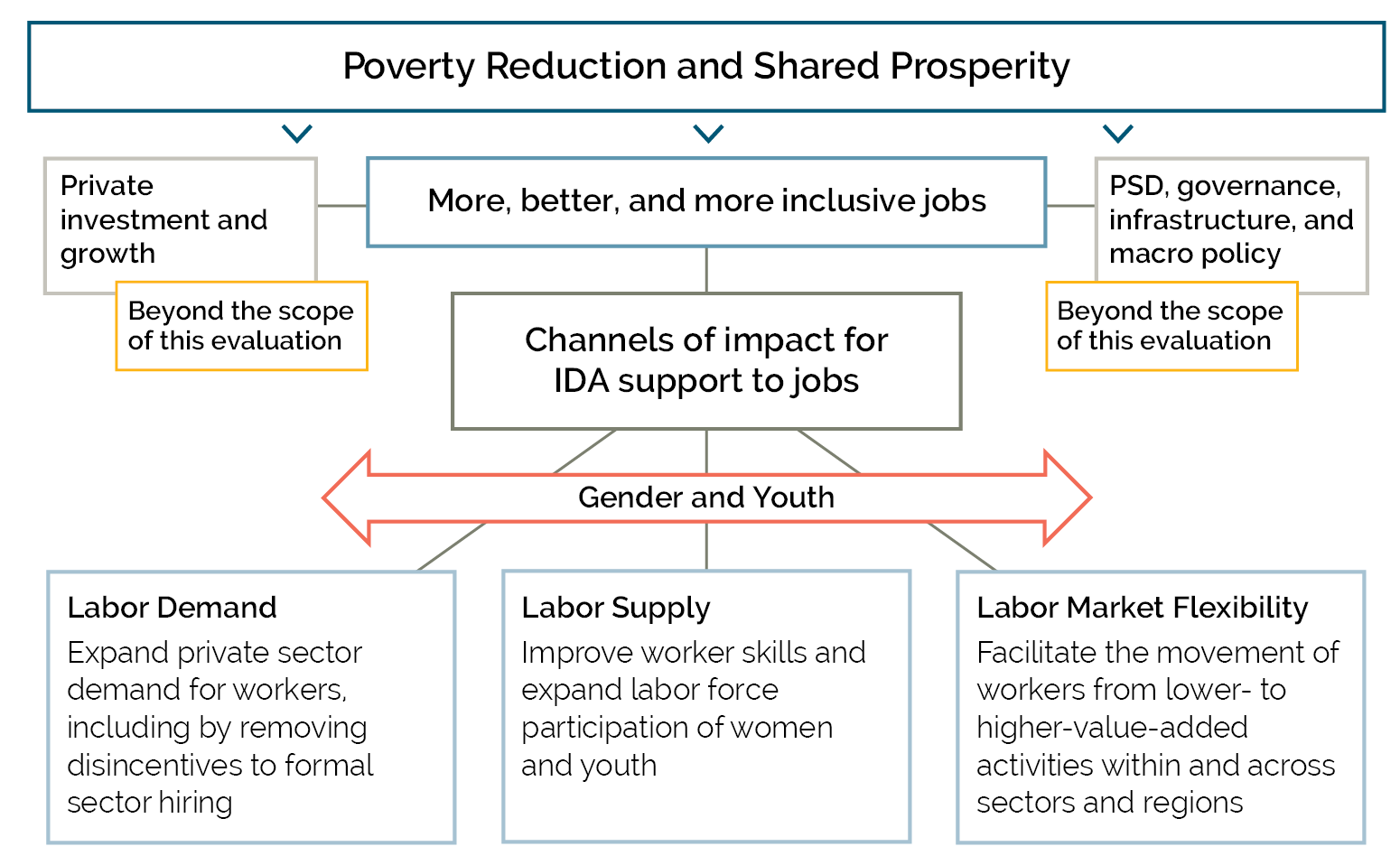
Source: Independent Evaluation Group.
Note: IDA = International Development Association; PSD = private sector development.
The evaluation portfolio consisted of 257 IDA-financed projects approved during fiscal years (FY)15–22 that supported at least one of the three IDA jobs-related objectives. The Independent Evaluation Group (IEG) identified these projects from the set of all IDA-financed projects by using a combination of data on the World Bank’s theme taxonomy (World Bank 2016), text mining, and review of project documentation. Manual review of operations was necessary because many operations mentioned jobs even when their content was only peripherally jobs related. As shown in table 1.1, the portfolio contained 216 investment project financings (IPFs) and 11 Programs-for-Results (PforRs) with IDA commitments of $24 billion and $1.3 billion, respectively. There were also 30 development policy operations (DPOs) with at least one jobs-relevant prior action. A summary of the portfolio based on lending instruments and project status is presented in table 1.1.
Table 1.1. IDA Jobs-Related Portfolio by Lending Instrument and Project Status, FY15–22
|
Lending Instrument |
Projects (no.) |
IDA Commitments (US$, millions) |
Projects with ICRR Ratings (no.) |
||||
|
Active |
Closed |
Total |
Active |
Closed |
Total |
Closed |
|
|
DPO |
0 |
30 |
30 |
n.a. |
n.a. |
n.a. |
16 |
|
IPF |
144 |
72 |
216 |
18,569 |
5,392 |
23,961 |
18 |
|
of which new |
131 |
43 |
174 |
17,327 |
4,100 |
21,427 |
18 |
|
of which AF |
13 |
29 |
42 |
1,242 |
1,292 |
2,534 |
0 |
|
PforR |
7 |
4 |
11 |
932 |
419 |
1,351 |
2 |
|
of which new |
6 |
3 |
9 |
782 |
373 |
1,155 |
2 |
|
of which AF |
1 |
1 |
2 |
150 |
46 |
196 |
0 |
|
Total |
151 |
106 |
257 |
19,501 |
5,811 |
25,312 |
36 |
Source: Independent Evaluation Group.
Note: AF = additional financing; DPO = development policy operation; FY = fiscal year; ICRR = Implementation Completion and Results Report Review; IDA = International Development Association; IPF = investment project financing; n.a. = not applicable (because DPO financing does not directly support individual prior actions); PforR = Program-for-Results.
Most jobs projects took place in the Eastern and Southern Africa Region. The geographic distribution of project counts and commitments for the jobs-related portfolio is shown in table 1.2, in absolute terms and relative to total IDA projects and commitments. The regional distribution of the jobs portfolio is broadly aligned with the overall distribution of IDA resources. The Eastern and Southern Africa Region had the highest proportion of IDA financing going toward projects with jobs-related interventions. At the country level, the countries with the highest proportion (more than 25 percent) of total IDA commitments in the evaluation portfolio, in descending order, were Honduras, Rwanda, the Democratic Republic of Congo, Cameroon, Ethiopia, Mali, Ghana, and Sierra Leone, and the countries with the lowest proportions (of less than 6 percent), in ascending order, were Afghanistan, Madagascar, Somalia, the Marshall Islands, Chad, the Lao People’s Democratic Republic, and Moldova.
Table 1.2. Geographic Distribution of IDA Jobs-Related Investment Project Financing and Program-for-Results Portfolio, FY15–22
|
World Bank Region |
Projects |
IDA Commitments |
||
|
Total (no.) |
As a share of total IDA (%) |
Total (US$, millions) |
As a share of total IDA (%) |
|
|
East Asia and Pacific |
23 |
10 |
1,227 |
10 |
|
Eastern and Southern Africa |
66 |
14 |
10,870 |
18 |
|
Europe and Central Asia |
13 |
10 |
640 |
9 |
|
Latin America and the Caribbean |
7 |
7 |
435 |
12 |
|
Middle East and North Africa |
7 |
13 |
480 |
12 |
|
South Asia |
36 |
15 |
5,323 |
15 |
|
Western and Central Africa |
75 |
15 |
6,336 |
13 |
|
Total |
227 |
13 |
25,312 |
15 |
Source: Independent Evaluation Group.
Note: Total IDA project counts include all projects in the Region with IDA financing, and total IDA commitments include all IDA financing to the Region. FY = fiscal year; IDA = International Development Association.
Most of the portfolio was led by three Global Practices (GPs): Agriculture and Food; Finance, Competitiveness, and Innovation; and Social Protection and Jobs. Table 1.3 provides the distribution of project counts and commitments (both in absolute terms and relative to total IDA) by the lead GP managing the projects and by the Practice Groups under which the respective GPs are mapped. The three GPs with the greatest focus on projects with jobs-related interventions, both in terms of IDA financing and share in total IDA financing, were Agriculture and Food, Social Protection and Jobs, and Finance, Competitiveness, and Innovation, which were spread across three Practice Groups (Sustainable Development, Human Development, and Equitable Growth, Finance, and Institutions).
Table 1.3. Practice Groups and Global Practices Managing IDA Jobs-Related Investment Project Financing and Program-for-Results Portfolio, FY15–22
|
Practice Group or Lead GP Managing Project |
Projects |
IDA Commitments |
||
|
Total (no.) |
As a share of total IDA (%) |
Total (US$, millions) |
As a share of total IDA (%) |
|
|
Equitable Growth, Finance, and Institutions |
34 |
30 |
3,229 |
31 |
|
Finance, Competitiveness, and Innovation |
34 |
30 |
3,229 |
31 |
|
Human Development |
78 |
13 |
8,602 |
15 |
|
Education |
34 |
22 |
2,654 |
15 |
|
Health, Nutrition, and Population |
2 |
1 |
153 |
1 |
|
Social Protection and Jobs |
42 |
26 |
5,795 |
30 |
|
Infrastructure |
11 |
6 |
1,856 |
9 |
|
Digital Development |
10 |
22 |
1,356 |
46 |
|
Transport |
1 |
1 |
500 |
3 |
|
Sustainable Development |
103 |
18 |
11,611 |
21 |
|
Agriculture and Food |
78 |
53 |
9,304 |
60 |
|
Environment, Natural Resources, and Blue Economy |
6 |
9 |
637 |
11 |
|
Social Sustainability and Inclusion |
11 |
19 |
497 |
10 |
|
Urban, Disaster Risk Management, Resilience, and Land |
7 |
4 |
1,040 |
6 |
|
Water |
1 |
1 |
134 |
1 |
|
Total |
226 |
16 |
25,219 |
18 |
Source: Independent Evaluation Group.
Note: Total IDA project counts include all projects managed by a GP with IDA financing, and total IDA commitments include all IDA financing managed by the GP. One project mapped to the erstwhile Trade and Competitiveness GP is excluded from the calculations. Governance and Poverty GPs under the Equitable Growth, Finance, and Institutions Practice Group had no projects in the portfolio. Projects not mapped to any of the GPs listed in the table are excluded from the calculation of total IDA commitments. Where more than one GP is involved in a project, the full amount is assigned to the “lead” GP; these figures may therefore understate the extent of involvement of some GPs. FY = fiscal year; GP = Global Practice; IDA = International Development Association.
This evaluation seeks to answer two main sets of questions. The first set of questions is addressed in chapter 2, which assesses the adequacy of the IDA jobs strategy through two main evaluation criteria: the suitability of the analytical underpinnings and operational relevance. The second set of questions is answered in chapter 3, which focuses on the portfolio of jobs interventions in IDA-eligible countries and assesses the relevance of design and performance of the operations.
- Evaluation question 1: To what extent is the IDA jobs strategy grounded in sound analytics, adaptive, and operationally relevant?
- Evaluation question 2: To what extent has the IDA jobs strategy been translated into relevant and effective jobs interventions?
The evidence to answer the evaluation questions stems from five main components. IEG conducted the following analysis (for more details, see appendix A):
- A structured literature review of the impact evaluation literature on jobs interventions.
- A portfolio review and analysis of 257 projects, using a mix of text mining and content analysis techniques to identify, classify, and assess jobs interventions and performance indicators.
- A before-and-after analysis of the number, commitment volumes, and interventions content of jobs-related projects based on “synthetic” portfolio data.
- Two structured country-level document reviews: (i) all 22 jobs diagnostics of IDA-eligible countries were manually coded to assess the strength of their analytical underpinning and the relevance of their recommendations, and (ii) 66 country strategies in 33 IDA-eligible countries were reviewed to compare jobs-related objectives, theories of change, results frameworks, prioritization of youth, and gender trends before and after IDA17.
- Thirteen in-depth country case studies, including within and cross-case analysis, based on a review of Project Appraisal Documents, Implementation Completion and Results Reports, and Implementation Completion and Results Report Reviews.
- IEG conducted nearly 100 interviews with staff from GPs, the Jobs Group, IFC, Country Management teams, the International Labour Organization, and donors and government counterparts (deep-dive case studies only).



